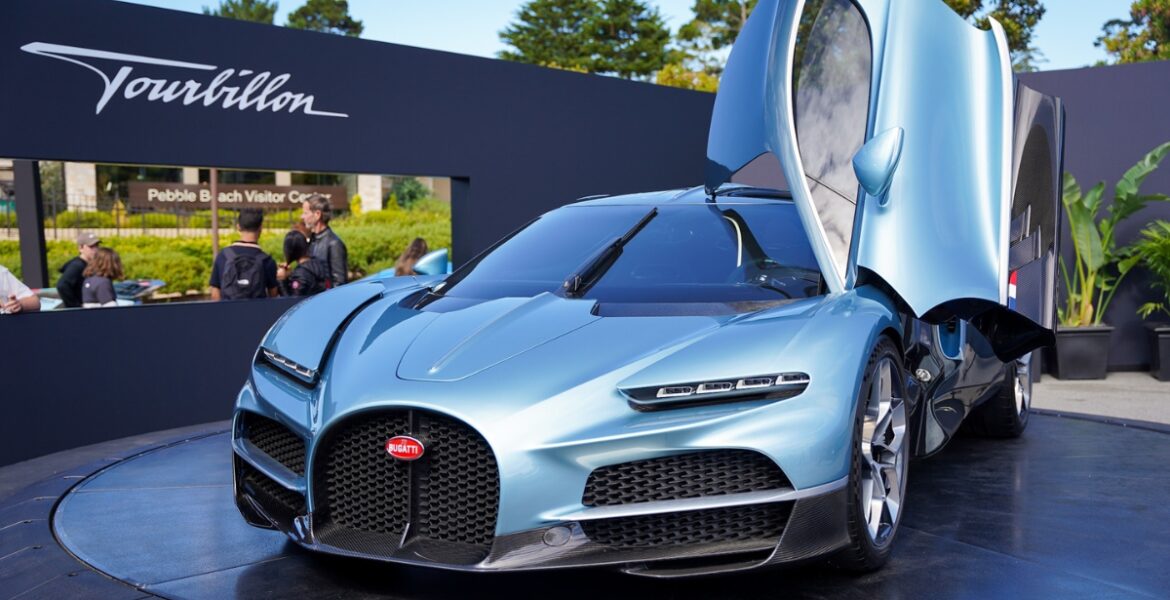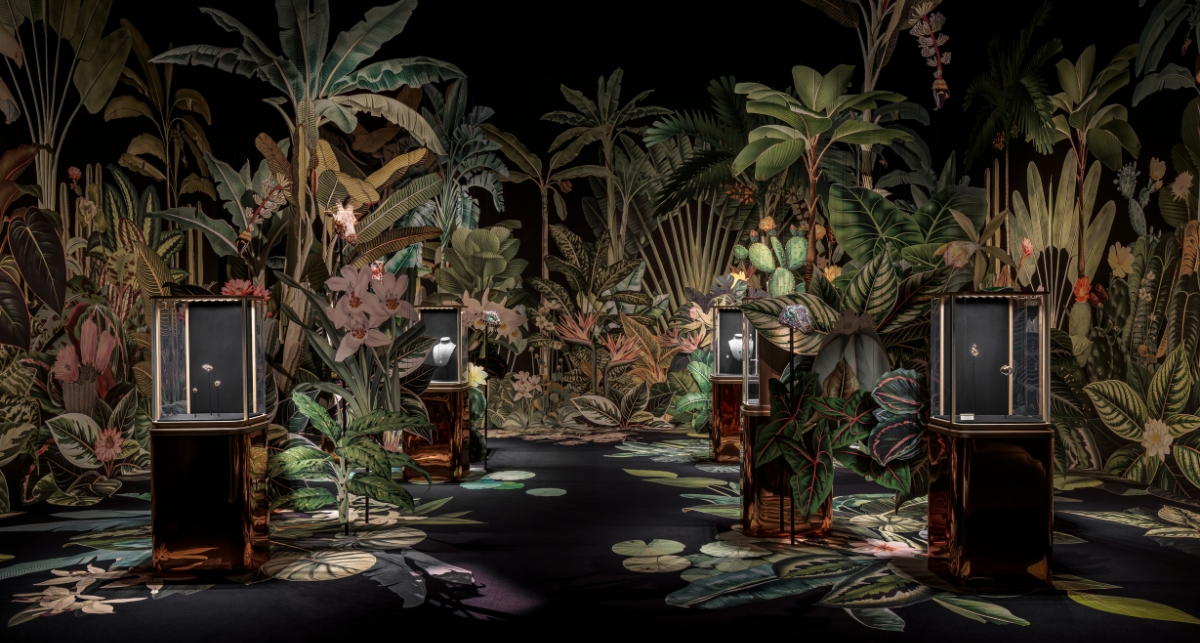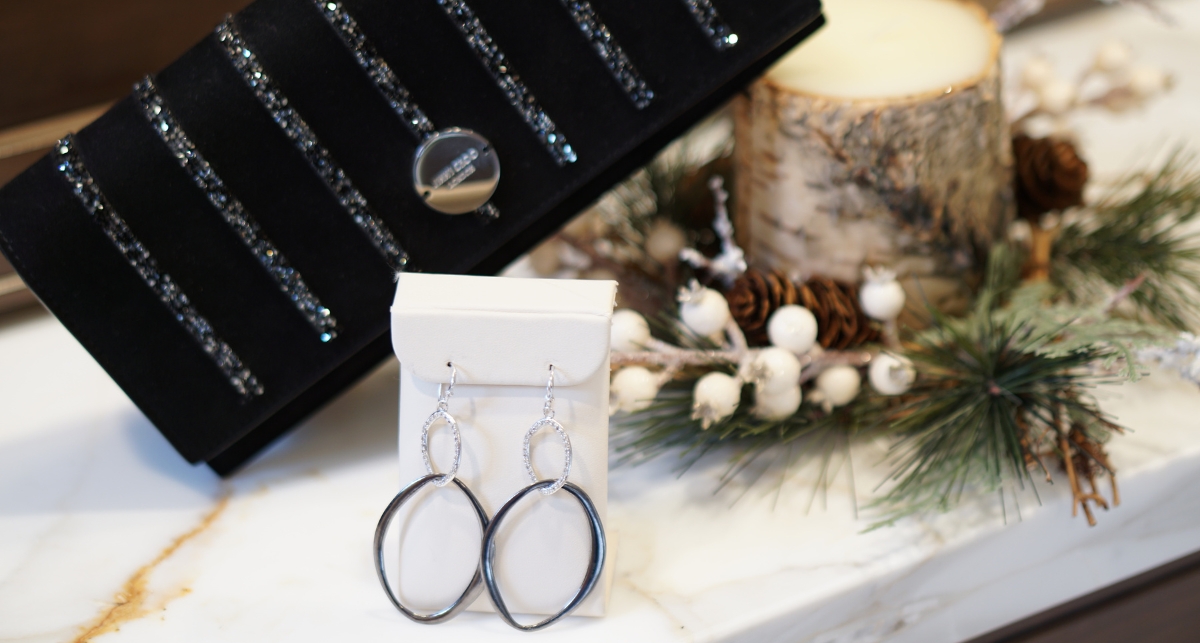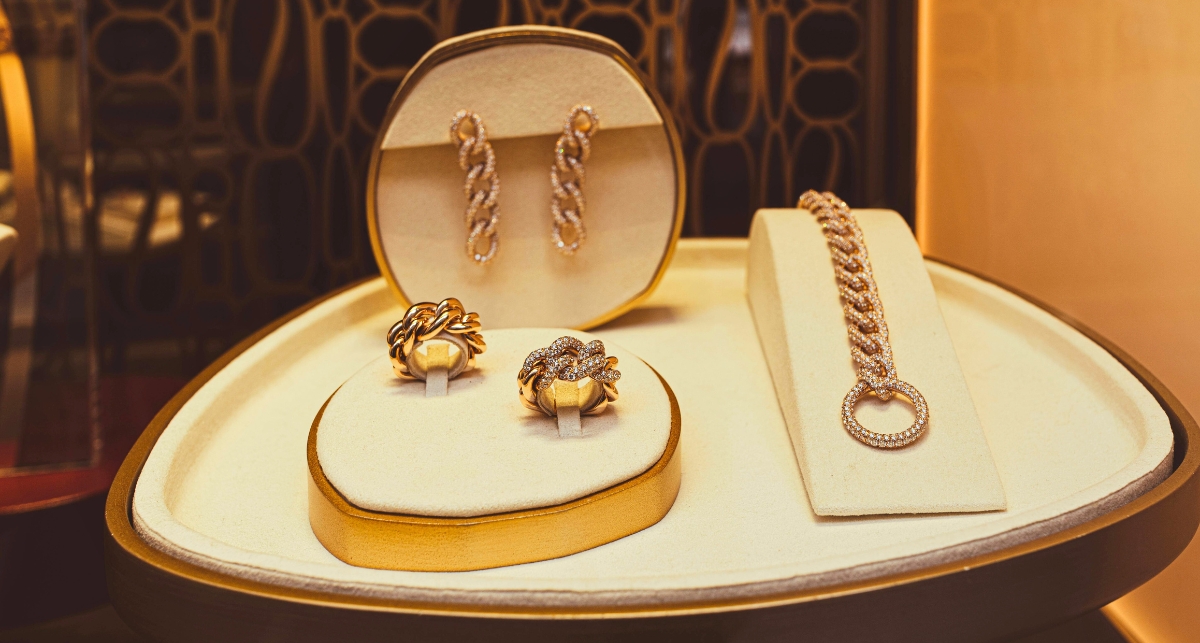For more than a century, Bugatti Automobiles have been driven by passion and engineered for perfection, creating a lasting legacy that has paved the way for the automobile industry. Founded by Ettore Bugatti, each car is highly coveted by automobile collectors for its superb design, outstanding performance, and reliability.
Over the company’s 115-year history, they’ve been fueling the dreams of high achievers while navigating the road to success within the ultra-luxury car realm, by producing many of the most powerful and opulent vehicles on the planet.

Bugatti Wins “Best of Show” at the 2024 Pebble Beach Concours d’Elegance
As evidenced by this, at the prestigious 2024 Pebble Beach Concours d’Elegance, this year’s coveted “Best of Show” award was granted to a 1934 Bugatti Type 59 Sports, which not only won the hearts of the judges but also wowed the audience when it drove up onto the award stand in front of thousands of spectators.
As stated on the Concours‘ website, “Thrilled owner Fritz Burkard exclaimed, ‘I’m so happy for the car, so happy for Bugatti. This car is incredible. It’s so much history—one of the most successful Bugattis in history—and to win with this car means a lot to me. First time a Swiss, first time a European wins, first time a preservation wins. It’s important that preservation also gets recognition, because a car can only be once original. And it drives so beautifully.’”

Charging into the 21st century, the company continues to honor the legacy of Ettore Bugatti and his son, Jean, ensuring every car is a bespoke masterpiece, with each customer experiencing something rare, special, and valuable. In truth, these cars are akin to rare gems.
To exemplify this further, today’s article highlights the beautiful new Bugatti Tourbillon, while discovering the design ethos of the brand (as explained by Bugatti Rimac Director of Design Frank Heyl and CTO Emilio Scervo), and learning the stories of one of Bugatti’s brand partners, Jacob & Co, and an enthusiastic Bugatti customer, Bilal Hydrie.

Bugatti Rimac Director of Designer Explains the Timeless Elegance of The Bugatti Tourbillon
Frank Heyl, a key figure in Bugatti’s design evolution, most recently took on a new role as Bugatti Rimac’s Managing Director of Design. With over 15 years at Bugatti, Frank significantly influenced the brand’s design language, contributing to iconic models like the Chiron, Divo, and Bolide. In his new role, he continues to push the boundaries of automotive design, blending Bugatti’s heritage with innovative, forward-thinking concepts that define the future of luxury hypercars.

CLP: Your journey to becoming the Director of Design for Bugatti is impressive. How has this journey shaped your design philosophy and leadership style?
FH: “I started at Bugatti in 2008. My first project was the Veyron Super Sport. We were trying to break the world record back then with a 1200 horsepower. And, I remember I had been working on that for a year and a half or so, and we had the prototype. One day, I was standing at our test track, which is almost a dual loop that is 8-kilometer straight. We were standing by the guardrails, and our test driver went by at around 200 mph – I remember it sounded like an aircraft or jet. So there I was, my trousers were shaking and my hair went woosh, and I thought to myself, ‘This is exactly what I want to be doing for the rest of my life!”.
CLP: I can imagine how thrilling that would feel.
FH: “Yeah, I’m a total car nut, gear head, petrol head – whatever term you want to use. I love cars.”
CLP: I’ve started to understand that, as the more I speak with designers and people who are in the industry, I realize that they are truly passionate about this. This is not just a job; it’s a dream job. And for many, it’s been a dream since they were a child. I think it’s pretty fascinating to connect with people who have a lifelong passion like that and can appreciate even a range of different brands. I’ve also seen that there’s a lot of collaboration that happens in the industry as well. While it is competitive and you’re all trying to get sales, there’s mutual support happening too.

CLP: Transitioning into a top leadership role often requires a shift in perspective as well as facing new responsibilities and mounting pressures. How have you adapted your approach to design and team management since stepping into this new position?
FH: “I’ve now been working 16 years on this particular brand. And, the design ethos that we developed, me as being part of the team now for 16 years and also with our former director, and now with my leadership – is the ‘form follows performance’ approach. Everything is done for a reason. We like to say ‘shaped by speed’.
There’s always some aerodynamic attribute or character tied to every shape that we make. May it be thermodynamic, an air intake or an air outlet, or about drag or downforce, trying to create a car that goes beyond 200mph, like Super Sport 200, or trying to create the ultimate lap time car, like Bolide – with big wings and downforce; there’s always a story connected. My job is not that much about doing the actual design work, as in modeling the car or sketching the car, although I do still sketch and like to model, rather, I regard my role as steering the ship and making the decisions to go the right course.”

FH: “There always has to tie in the aspect of timelessness. Our cars have been around for decades if not centuries. They endure through time in automobile connoisseurs’ garages, and will still be around for years. This week, we had the Type 35 at Laguna Seca. The car is from 1924, but still racing around the racetrack 100 years after it was built.
It was a fantastic picture which I aimed to have for a long time. We knew it would be the 100th anniversary of Type 35 in August, so we thought the perfect place to have this special celebration on the track i Laguna Seca. It shows a 100-year difference, especially in regards to technology.”

FH: “But that’s why I also say – ‘How do you make a car timeless?’ It’s got to be authentic to be timeless, and it has to tell a story. The story of the Tourbillon is the interplay between speed and elegance. What I also like to say is – ‘We are kind of trapped in the technology of our time’. What dates a car is the technology.
If you look at a car from 10 years ago and play around with the navigation system, it’s a rather unpleasant experience. We don’t want to be ridiculous in 100 years here on the lawn (at Concours). That’s why we strive for this whole aspect of trying to make it as timeless as possible while trying to be as little trapped in the technology of our time. For example, using true materials rather than big screens. We cannot afford to run after trends, because that’s not for us.”

CLP: I appreciate that. I saw one of your videos in which you talked about retaining a sense of timeless elegance. I respect that because it goes back to the legacy of the brand as well.
I think so often these days, executives and designers are being pressured, whether by a Board or a P&L statement, to make decisions that will hopefully accelerate sales, while keeping the brand DNA. But at the same time, sometimes they steer so off course that the brand doesn’t even know what it is anymore.
Your team has a unique ability to translate elegance and traditional details into the car, while still modernizing it. My point is – when you see a Bugatti, you instantly know it’s a Bugatti. Some of my favorite older cars are Bugatti, as they’re simply stunning. I think that it’s to be commended because, in my opinion, the brands that will have the greatest longevity are the ones that know who they are and stay true to that, regardless of what their competitors are doing.

CLP: Bugatti’s design ethos is centered around merging elegance as we’ve discussed, with speed and performance. How do you ensure every new model embodies this philosophy while still feeling fresh and exciting, and integrating new technology?
FH: “I see every person working on the car as part of the development team. Having a good bond with the C-level and management team to fully understand and mesh into each other’s divisions is important. I don’t like to say – ‘There’s the design team, the styling team, and the engineering team’.
I believe every designer needs to understand the technologies; I take that very seriously.
You need to understand chassis balance, structural integrity, manufacturability, light guides, fundamental aerodynamics, etc. You don’t need to be a total expert on these aspects, but you need to have a basic understanding of all these things, which I learned on the job. And, I believe that only what you love to do can you be really good at.”

CLP: Bugatti designs are nothing short of breathtaking. What are some of the most significant sources of inspiration that fuel your passion for auto design? It could be architecture, sculptures, art, films, etcetera. Anything that influences your creative vision outside of the automotive world in particular.
FH: “That’s a complex process.”
CLP: Jascha told me that sculptures inspire him and said that Ettore’s brother was a sculptor. Is that correct?
FH: “Yeah, Bugatti is a family of artists.
Rembrandt Bugatti sculpted these amazing pieces from clay with his own hands, which were then cast into bronze. If you get a hold of one of these, it’ll be worth millions today. For example, he made the dancing elephant, which became the figure for Bugatti. So, that’s a huge source of inspiration – our past.
You have to look at the past to understand where he came from to project the same principles onto the future. Bugatti had a certain philosophy to not only do whatever is technically the most efficient to do, but it had to have a certain touch to it – in terms of aesthetics, preciousness, and longevity. That’s why he had a huge influence on our thinking, even 100 years later.”

FH: “I cannot be only facing backward, as I have to project myself into the future by 4 years if not more. That’s why we cannot afford to go on a trendy thing, we have to stay timeless. The inspiration from the past is important, but obviously, there are certain ideals we need to meet.
We talked about Fibonacci numbers the other day. You might have seen the Fibonacci half-circles which pertain to the rule of proportions. Similar to photography, like the ‘rule of thirds’. Based on this, the Tourbillon equals 1.6. If you look at it from the top view, it has this coke-bottle shape. Then, when we dive in between the wheels, it resembles the curved hips of a person.
The car is really about sculpture and reflection. There’s a logic to beauty, and it’s based on being proportionate.”

CLP: As you continue to shape the future of Bugatti’s design language, what legacy do you hope to leave behind one day?
FH: “I have a dream. I have 2 little daughters and hope one day they will have children. My vision is that one day, when I can barely walk, maybe I’ll stroll the lawn at one of these events with my grandchildren and say to them, ‘Your old grandpa worked on that when he was a bit younger’. That’s my wish.”

CLP: Final question – What was the inspiration behind the tourbillon? In particular, I’ve learned that the name tourbillon means whirlwind, which came from a watch. Is that correct? So, I’m curious about the inspiration behind the name, and what differentiates it from the other models.
FH: “Yes. It’s a two-fold question. The main thing is, before we even speak about any design or color, we’ve got to get the proportions right, as that’s the most difficult part. Through experience, you develop the eye to know how to place volumes together so they stand in proportion to one another.
Secondly, regarding the name Tourbillon, we love analog watches, especially the tactility in all their mechanical elements – how the cogs come together. You know – the complications, the skeletonization, and the aspect of transparency, as you can look through the center console since there’s exquisite glass. If the interior is supposed to be timeless, it’s got to be like a digital detox. We want to invest in things that were lost and not founded on screen-based technologies. So, there are mechanical toggle switches, real glass, and ruby stone bearings. The art of watchmaking lends itself to this, as the interior is like a big watch.
Finally, what is the highest degree of complication in the art of watchmaking? It’s a tourbillon. A tourbillon is essentially a cage immune to any centrifugal or gravitational forces because of the power reserve, once you wind it up, it preserves its power. It came from wearing pocket watches. That’s where the name came from, and it perfectly lends itself to this ultimate complication of car.”

Bugatti Rimac CTO Explains The Pursuit of Excellence Behind The Tourbillon
At Monterey Car Week last year, I had the pleasure of speaking with Emilio Scervo (pictured below), the Chief Technology Officer for Bugatti Rimac. In addition to discussing the tech-forward advancements of the hypercars they design and produce, I learned more about the rapidly growing company’s background, which is unbelievably impressive, given the remarkable entrepreneurial journey that Mate Rimac underwent.
To give you a little background, while the Bugatti brand has been in existence since 1909, several years ago, Rimac Automobili (a Croatian hypercar manufacturer that broke world records with its uber-fast Rimac Nevera), acquired Bugatti, thereby forming a joint venture called Bugatti Rimac. While Rimac Automobili and Bugatti Automobiles operate each brand separately, the “two brands were united under the business decision of Porsche, giving control of Bugatti to (Rimac founder) Mate Rimac and in return receive more share in Rimac Group, which includes Rimac Technology, a company that develops batteries and powertrains” (as explained by Wikipedia) for other auto manufacturers, such as Automobili Pininfarina.

During this year’s event, I caught up with Emilio at Le Domaine Bugatti and discussed the spectacular new Bugatti Tourbillon. He said, “The Tourbillon is the ultimate epitome of our tenacious determination, profound passion, and relentless pursuit of excellence. We have been challenging ourselves, always questioning if what we did was enough. It’s been hard work, but we have enjoyed every single moment of it and the final result is a priceless award: having created a timeless masterpiece.”
The Jacob & Co Bugatti Tourbillon Luxury Timepiece Debuts at Monterey Car Week
From what I’ve learned, owning a Bugatti is more than just possessing an extraordinary car; it becomes an extension of your lifestyle, influencing various facets, including what you wear.
To exemplify this, the company’s collaboration with Jacob & Co. (the world-famous luxury watch brand known for crafting intricate timepieces worn by celebrities and collectors, including the elaborate Bugatti Tourbillon timepiece), proves that Bugatti customers don’t just desire to drive the cars, they want it to become an integral part of their style.
“Inspired the impossible” is the mantra upon which Jacob & Co follows to create many of the most magnificent watches on the planet. Founded by Jacob Arabov in 1986, the family-owned and operated company is driven by creativity and charged with a penchant for designing unique, bespoke luxury watches that exceed all expectations.
Similar to many ultra-luxury goods customers’ narratives, as reported in a Forbes article, “Jacob Arabo’s rise in the luxury watch and jewelry industry is a true rags-to-riches story. He arrived in the U.S. from Uzbekistan and spent his teenage years learning the jewelry trade, eventually creating his own pieces before launching as Jacob & Co. in 1986… (when) his designs caught the attention of Hip-Hop artists, he became a celebrity in his own right known as ‘Jacob the Jeweler’.”

As explained on the company’s website, “In 2019, Bugatti Automobiles and Jacob & Co. entered into a partnership agreement, based on a shared focus on extreme luxury, mechanical performance and craft. Both brands have been working together to create unrivaled hypercar-inspired timepieces.
‘Working closely with Bugatti is an exciting experience,’ says Jacob Arabo, Jacob & Co. Founder and Chairman. ‘I live to push watchmaking to new levels, coming up with designs and complications that no one had even dreamed about. Bugatti is the same. They push everything beyond what everyone thinks is the limit. The Bugatti Tourbillon is our most advanced timepiece, the great achievement of a great partnership.'”
During Monterey Car Week 2024 at Le Domaine Bugatti (at The Lodge in Pebble Beach, California), I spoke with Jacob’s son, Benjamin Arabov (Chief Executive Officer of Jacob & Co. and Forbes ‘30 under 30′ honoree) about their partnership with Bugatti and the highly-anticipated debut of this new watch, designed to mimic the Bugatti Tourbillon hypercar specifically.

This exceptional timepiece introduces innovative designs and complications, closely reflecting the car’s architecture.
They explain the connection between the watch and the car is visual and functional, with precision and similarity never seen before. Ten key design features of the watch are directly inspired by the car, including the case shape, which mirrors the car’s front grille and radiator inlets, and the large sapphire side openings that resemble the car’s tinted windows. The sub-dials mimic the car’s dashboard and rpm counter, while the automaton replicates the V16 engine with exhaust manifolds. Even the winding crown is crafted to resemble the car’s control knobs.
Bugatti’s Bespoke Process for Crafting Timeless Collectibles
The bespoke experience lies at the core of Bugatti’s ethos, as I learned last year speaking with Jascha Straub (Bugatti Lead Designer for Sur Mesure, pictured below). During our chat, he explained the intricately involved process of hyper-customization they undergo when working closely with each customer to ensure that every Bugatti car exceeds their high expectations.

As exemplified by this, I spoke with one of their enthusiastic customers, Bilal Hydrie, a successful entrepreneur and executive who purchased the last Bugatti 1500hp Chiron.
During our enlightening conversation, he explained that while he’s been an avid supercar collector (owning Lamborghini, Rolls-Royce, and other prestigious vehicles), he always dreamed of buying a Bugatti, as it was his ultimate wishlist vehicle. However, the process of acquiring this cherished dream car wasn’t easy.
It not only challenged him to grow his business to the level of prosperity that could enable him to purchase a $3M hypercar (which was no easy feat, given that he was an immigrant from Pakistan who became a self-made success), but it was more involved than just having the funds to pay for it. It required going through an interview with Bugatti, enduring years of patience through an extensive customization process (working with Jascha and their team), and even a memorable visit to the esteemed Molsheim, France facility.

CLP: As evidenced by your impressive Instagram feed and the numerous press articles about your acquisition of Bugatti Chiron, including a feature story by The Wall Street Journal, you’re clearly passionate about Bugatti as a brand. What is it about Bugatti that resonates with you on a deeper level beyond just the incredible performance and spectacular design?
BH: “I’ve been passionate about cars since I was very young. I grew up in Dubai and Pakistan and saw all these luxury cars all around. For me, the journey to owning a Bugatti started as just a dream. As my business became more successful, I started getting into buying Ferraris and Lamborghinis, and then I decided I wanted the best of the best, and there’s nothing better than Bugatti, to be honest with you. Bugatti is just more than just a fast car. I feel like it’s about the passion and innovation behind it. The brand represents pushing boundaries and doing things differently. That’s what draws me in. It’s just like when you get into the Bugatti factory, all you see are about 10 or 15 people working there. And, then, the history and the legacy behind it, that’s what drives this brand.”

CLP: As someone who owns multiple supercar brands, such as Rolls Royce and Lamborghini (as evidenced by your Instagram), what sets the Bugatti Chiron apart from your other vehicles, and what does it symbolize in your collection?
BH: “Chiron is in a league on its own. It’s like owning an aircraft or a yacht.”
CLP: In one of your Instagram posts, you said, ‘Introducing my new Bugatti Chiron, my biggest achievement to date and the most exceptional experience at the factory in France. I’ve driven every car under the sun, but this is just out of this world.‘ So what was it about the Bugatti Chiron, in particular, that made it a dream car for you? How did it feel to finally see your vision become reality after waiting over a year for it to be completed?
BH: “Seeing the Chiron being built was just incredible. It was a unique experience that I had because you can’t just get into the Bugatti factory. They make sure you are eligible to get into their dealership. So, the first process was working on getting an allocation, and they conducted an interview inquiring as to ‘Why do you want to own it? Have you ever owned anything like this?’ It was kind of like an interview, and then I was lucky enough to get an allocation after my story and passion for this car, so they gave me the world’s last allocation for the Chiron.
Then seeing the Chiron built was just incredible. It’s like watching a masterpiece come to life. The whole experience became even more personal and rewarding. They show you the entire process, enabling you to watch step-by-step. You go in and sit down with them, have dinner and lunch, and then we talk about my choices about what I wanted it to look like. Working one-on-one with Jascha was amazing. It was so much back and forth. The thing is, Bugatti has very high standards. For example, some ideas on customization would need to be approved by their management.”

CLP: Your car was the last production model of the 1500hp Chiron series, marking the end of an era for the brand, which makes it rather unique. Why was it important to own this piece of automotive history? How does it make you feel to be a pivotal and significant customer in this aspect?
BH: “For me, winning the last of the 1500 horsepower Chiron feels like being a part of something historic. It’s just so cool to have a piece of automotive history and to know you’re among the few who have it.”
CLP: Your visit to the beautiful Molsheim factory must have been an unforgettable opportunity. Can you share what it was like to see your Bugatti being hand-built and how that experience left a memorable impression on you?
BH: “Working with the Bugatti design team was a blast. They listened to my ideas and turned them into something amazing. It was cool seeing the vision come to life in a way that I didn’t expect. Jascha was passionate about making sure he knew what I wanted because they always wanted to give the customer what they wanted. They also have protocols in place with requirements that need to be filled. It was a great experience.”
CLP: Working closely with Bugatti’s design team, including Jascha Straub, Bugatti’s lead designer for Sur Mesure, to create a bespoke hypercar is no small feat. What were some of the unique aspects of the customization process that exceeded your expectations?
BH: “The experience working with Jascha and the design team was amazing. The level of detail and customization was just beyond anything that I expected. Every choice that I made felt personal and was crafted to perfection.“

CLP: Why did you select some of the notable styling elements such as the Nocturne and copper colors, and was there greater significance in those particular colors in the overall design choices you did select?
BH: “I originally wanted 24k gold, because the whole idea was that I wanted to experience this car in the countries where people haven’t seen it. I intended for this car to travel with me to Europe, and other places like India, Pakistan, and Dubai. That was my original vision. I thought, why not go with a rich look like gold; so, we decided on this rose gold-looking color, as it reflects my style and was just a bold move.
I worked so hard to go from where I started to where I am now. So, I thought – it has to stand out. As an immigrant coming from Pakistan, it wasn’t easy. I was never just handed money; I had to build everything from scratch. There was a lot of door-knocking over the years, and it was hard to build relationships. It took a lot of years for me to get where I am now. I’ve created jobs in our country and want to inspire other immigrants from different countries to believe they can achieve all of their dreams.
You must be passionate about what you do, be driven, dream big, and work hard.”

CLP: The day you first drove your Chiron must have been exhilarating. How did that moment feel, and what did it represent in the context of your personal and professional journey?
BH: “Driving the Chiron for the first time felt unreal. It felt like a huge win. It was just a reminder of what you can achieve with hard work and persistence. That was the main thing.”
CLP: What does this achievement of owning the last 1500 horsepower Bugatti Chiron mean to you on a personal level? How does it align with your broader goals and aspirations as a car collector and a driven success-oriented person?
BH: “I feel like owning a Chiron is just a big personal and professional milestone. It’s a symbol of reaching your goals, celebrating your success by pushing yourself, and making dreams come true.”
CLP: For readers who wish to own a hypercar or achieve other significant life goals, what advice would you give them to inspire them to passionately pursue their dream life through hard work and determination just as you have?
BH: “Stay focused on your dreams and work hard towards them. Do things that inspire you. For example, even though I now own luxury goods, I also have taken care of people in life. I help charities and do other good things that make me feel better inside. To me, luxury is more than just material possessions, to be honest with you. It’s about pursuing excellence in everything you do.”

As evidenced by the brand’s lasting legacy and unparalleled designs, which create an enthusiastic group of customers, Bugatti continues to prove that it’s more than just another ultra-luxury auto brand – it’s an incomparable investment and a symbol of success built to stand the test of time. To learn more about the company and its lineup of models, visit Bugatti’s website.
If you enjoy discovering the tales of Monterey Car Week, follow along on MSN and Instagram, as I’ll be sharing more Car Week stories featuring in-depth interviews with industry leaders, C-level executives, and head designers from notable brands over the next few weeks.

















